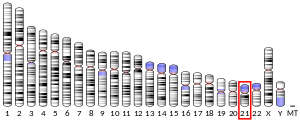Pr/set domain 15
PR/SET domain 15 is a protein that in humans is encoded by the PRDM15 gene.[5]
PRDM15 safeguards naive pluripotency by transcriptionally regulating WNT and MAPK-ERK signaling.[6]
PRDM15 modulates WNT and MAPK/ERK signaling by directly promoting the expression of Rspo1 (R-spondin1) and Spry1 (Sprouty1). Mzoughi et al., have shown that PRDM15 binds to the promoter region of both genes, inducing changes in the local chromatin to promote their transcription. In a second report, the same team has identified a loss-of-function mutation in patients with holoprosencephaly and microcephaly. They used mouse models and embryonic stem cells to uncover an unexpected link between Notch and WNT/PCP signaling and early embryo patterning. Both pathways are deregulated in PRDM15 mutants, leading to patterning defects and a spectrum of anterior brain malformations.[7]
See also
References
- ^ a b c GRCh38: Ensembl release 89: ENSG00000141956 – Ensembl, May 2017
- ^ a b c GRCm38: Ensembl release 89: ENSMUSG00000014039 – Ensembl, May 2017
- ^ "Human PubMed Reference:". National Center for Biotechnology Information, U.S. National Library of Medicine.
- ^ "Mouse PubMed Reference:". National Center for Biotechnology Information, U.S. National Library of Medicine.
- ^ "Entrez Gene: PR/SET domain 15". Retrieved 2018-07-24.
- ^ Mzoughi S, Zhang J, Hequet D, Teo SX, Fang H, Xing QR, et al. (September 2017). "PRDM15 safeguards naive pluripotency by transcriptionally regulating WNT and MAPK-ERK signaling". Nature Genetics. 49 (9): 1354–1363. doi:10.1038/ng.3922. PMID 28740264. S2CID 205355109.
- ^ "PRDM15 loss of function links NOTCH and WNT/PCP signaling to patterning defects in holoprosencephaly". doi:10.1126/sciadv.aax9852.
{{cite journal}}: Cite journal requires|journal=(help)




